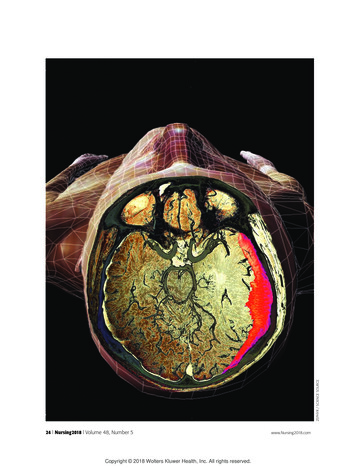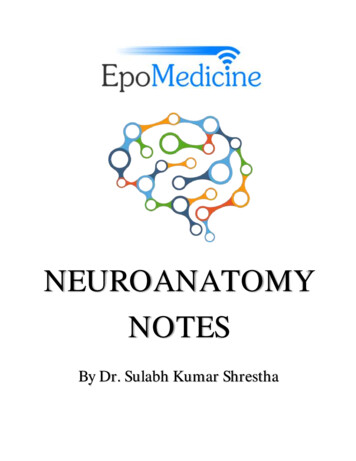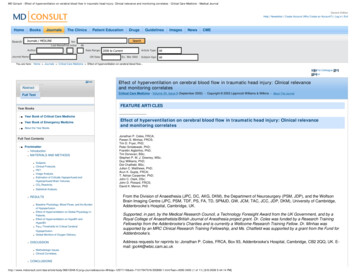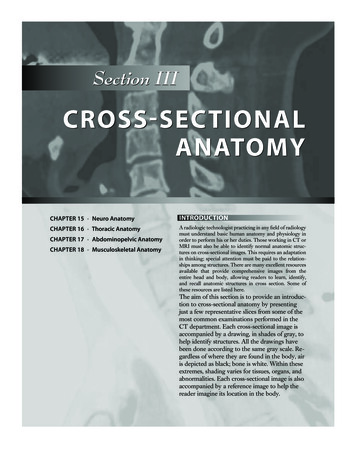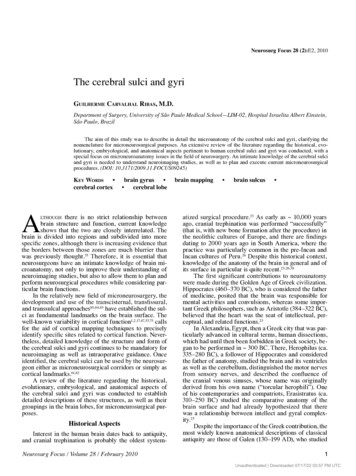
Transcription
Neurosurg Focus 28 (2):E2, 2010The cerebral sulci and gyriGuilherme Carvalhal Ribas, M.D.Department of Surgery, University of São Paulo Medical School—LIM-02, Hospital Israelita Albert Einstein,São Paulo, BrazilThe aim of this study was to describe in detail the microanatomy of the cerebral sulci and gyri, clarifying thenomenclature for microneurosurgical purposes. An extensive review of the literature regarding the historical, evolutionary, embryological, and anatomical aspects pertinent to human cerebral sulci and gyri was conducted, with aspecial focus on microneuroanatomy issues in the field of neurosurgery. An intimate knowledge of the cerebral sulciand gyri is needed to understand neuroimaging studies, as well as to plan and execute current microneurosurgicalprocedures. (DOI: 10.3171/2009.11.FOCUS09245)Key Words cerebral cortexAbrain gyrus cerebral lobethere is no strict relationship betweenbrain structure and function, current knowledgeshows that the two are closely interrelated. Thebrain is divided into regions and subdivided into morespecific zones, although there is increasing evidence thatthe borders between those zones are much blurrier thanwas previously thought.35 Therefore, it is essential thatneurosurgeons have an intimate knowledge of brain microanatomy, not only to improve their understanding ofneuroimaging studies, but also to allow them to plan andperform neurosurgical procedures while considering particular brain functions.In the relatively new field of microneurosurgery, thedevelopment and use of the transcisternal, transfissural,and transsulcal approaches80,84,85 have established the sulci as fundamental landmarks on the brain surface. Thewell-known variability in cortical function1,2,17,47,53,75 callsfor the aid of cortical mapping techniques to preciselyidentify specific sites related to cortical function. Nevertheless, detailed knowledge of the structure and form ofthe cerebral sulci and gyri continues to be mandatory forneuroimaging as well as intraoperative guidance. Onceidentified, the cerebral sulci can be used by the neurosurgeon either as microneurosurgical corridors or simply ascortical landmarks.61,62A review of the literature regarding the historical,evolutionary, embryological, and anatomical aspects ofthe cerebral sulci and gyri was conducted to establishdetailed descriptions of these structures, as well as theirgroupings in the brain lobes, for microneurosurgical purposes.lthoughHistorical AspectsInterest in the human brain dates back to antiquity,and cranial trephination is probably the oldest systemNeurosurg Focus / Volume 28 / February 2010brain mapping brain sulcus atized surgical procedure.23 As early as 10,000 yearsago, cranial trephination was performed “successfully”(that is, with new bone formation after the procedure) inthe neolithic cultures of Europe, and there are findingsdating to 2000 years ago in South America, where thepractice was particularly common in the pre-Incan andIncan cultures of Peru.26 Despite this historical context,knowledge of the anatomy of the brain in general and ofits surface in particular is quite recent.23,26,38The first significant contributions to neuroanatomywere made during the Golden Age of Greek civilization.Hippocrates (460–370 BC), who is considered the fatherof medicine, posited that the brain was responsible formental activities and convulsions, whereas some important Greek philosophers, such as Aristotle (384–322 BC),believed that the heart was the seat of intellectual, perceptual, and related functions.23In Alexandria, Egypt, then a Greek city that was particularly advanced in cultural terms, human dissections,which had until then been forbidden in Greek society, began to be performed in 300 BC. There, Herophilus (ca.335–280 BC), a follower of Hippocrates and consideredthe father of anatomy, studied the brain and its ventriclesas well as the cerebellum, distinguished the motor nervesfrom sensory nerves, and described the confluence ofthe cranial venous sinuses, whose name was originallyderived from his own name (“torcular herophili”). Oneof his contemporaries and compatriots, Erasistratus (ca.310–250 BC) studied the comparative anatomy of thebrain surface and had already hypothesized that therewas a relationship between intellect and gyral complexity.23Despite the importance of the Greek contribution, themost widely known anatomical descriptions of classicalantiquity are those of Galen (130–199 AD), who studied1Unauthenticated Downloaded 07/17/22 05:57 PM UTC
G. C. RibasFig. 1. Renaissance illustrations of the brain sulci and gyri with a configuration that resembles the small bowel disposal. Left:By Andreas Vesalius, 1543.65 Right: By Raymond Vieussens, 1684. Reprinted from Vieussens R: Nevrographia Universalis.Frankfurt: Georgium Wilmelmum Künnium, 1690.anatomy in Alexandria, returned to Greece, and finallysettled in Rome, where he was surgeon to the gladiatorsand performed dissections, primarily on animals.38The Middle Ages, roughly from the 4th to the 14thcentury, is well known to have been poor in terms of scientific developments in general. Although there were somecontributions from individuals in certain regions—in theArabic world, from Avicenna (980–1037 AD), who someauthors credit with the first representation of the brain,made in 1000 AD;69 and in Europe, from Mundino deiLuzzi,69 who, in 1316, performed the first human dissections reported in Europe—anatomical studies were quitelimited, principally because of the prohibition against thedissection of human cadavers. During the Renaissance,this prohibition was finally lifted, which led to the progressive development of all anatomical knowledge. The mostpreeminent figure in this field was undoubtedly AndreasVesalius (1514–1564), professor of anatomy and surgery atthe University of Padua, who published the textbook DeHumanis Corporis Fabrica,65 in which he pointed out themany errors made by Galen, outlined the distinctions between white matter and gray matter, and described variousother aspects of brain anatomy.23,38,69Although Vesalius provided intricate anatomical descriptions, especially of the ventricular cavities and theirrelated deep neural structures, illustrations of the brainconvolutions, including those of Vesalius, continued toshow them in a chaotic arrangement. Among other notable Renaissance authors were the great Leonardo da Vinci(1472–1519), who, in addition to his elegant descriptionsof the brain ventricles, created beautiful illustrations ofthe brain surface,12 and Julius Casserius (ca. 1545–1616),who depicted the brain convolutions, which were at thattime understood to resemble the small bowel (Fig. 1).69In 1663 Franciscus de la Böe (1614–1672), also knownas Dr. Sylvius, described the lateral cerebral sulcus, whichtherefore came to be known as the sylvian fissure.23In 1664 Thomas Willis (1621–1675) published his2highly regarded Cerebri Anatome, which featured illustrations by the renowned architect Christopher Wren(1632–1723). In addition to describing the group of arteries surrounding the base of the brain (now known asthe circle of Willis), Willis introduced a variety of terms,including neurology, hemisphere, lobe, corpus striatum,peduncle, and pyramid, and showed a relationship between the cerebral gyri and memory.23Raymond Vieussens (1644–1716) published the famous Neurographia Universalis in 1690,76 describing indetail the “centrum semiovale” and other cerebral structures but still illustrating the brain surface similarly to thesmall bowel.23,69 Godefroid Bidloo clearly displayed thecentral sulcus in his atlas and textbook published in 1685,69and subsequently Félix Vicq d’Azyr (1748–1794), famousfor describing the mamillothalamic tract, also describedthe precentral and postcentral convolutions and coinedthe term uncus.69 Later, Johann Christian Reil (1759–1813)provided a comprehensive description of the insula, whichhad been identified by Bartholin in 1641.23,69 In 1827 Herbert Mayo, student of the renowned anatomist and surgeonCharles Bell (1774–1842), published illustrations of thecorona radiata and the internal capsule as well as otherimportant tracts.74 In 1829, the Italian anatomist Luigi Rolando (1773–1831) published his text Della Strutura degliEmisferi Cerebrali,63 becoming the first author to accurately portray the cerebral sulci and convolutions, including thecentral sulcus, which later received his name and is stilloccasionally referred to as the fissure of Rolando.23,74It was the German physiologist Friedrich Arnold(1803–1890) who first used the terms frontal, parietal,and occipital to describe the cranial bones. In a text published in 1851, 5 Arnold recognized only the sylvian fissure and the parietooccipital sulcus (then known as theinternal perpendicular fissure) as anatomically constantsulci. He did not recognize any organized arrangementamong the cerebral gyri, and he described the temporalregion as an anterior extension of the occipital region.Neurosurg Focus / Volume 28 / February 2010Unauthenticated Downloaded 07/17/22 05:57 PM UTC
The cerebral sulci and gyriTABLE 1: Mammalian cortical development*Primitive Cortex: Allocortex(3 layers)Medial Cortical Ring: Mesocortex(6 layers)limbic xolfactory or piriform cortexparalimbic structures & insulaparahippocampal gyruscingulate gyrusinsulaLateral Cortical Ring: Isocortex(6 organized layers)parainsular & other neocortical structuresneocortexmotor cortexsensory cortexvisual cortexauditory cortexlanguage cortices (humans)rest of neocortex, associative areas* Adapted from Sarnet and Netsky.The French anatomist Louis Pierre Gratiolet (1815–1865) provided the first accurate descriptions of the cerebral lobes and cerebral fissures.6,72,74 In addition to hiswell-known description of the optic radiation, Gratioletalso distinguished between primary and secondary sulcibased on their phylogenetic appearance and adopted theterms initially proposed by Arnold to divide each cerebral hemisphere into 5 lobes (frontal, parietal, occipital,temporal, and insular). Gratiolet coined the elegant termplis de passage to describe the connections between adjacent gyri. He was the first anatomist to understand anddescribe the fact that despite individual variations, thecerebral sulci and gyri are organized in accordance witha general arrangement.27,74 It is notable that despite theintense interest that humankind has always had in relationto the brain, it was only in the middle of the 19th centurythat the anatomical organization of the cerebral sulci andgyri was perceived and described.The work of Gratiolet laid the foundation for the important studies later conducted by the French anatomist,anthropologist, and surgeon Paul Broca (1824–1880),who examined the cerebral sulci and fissures. Broca wasthe first to describe the craniocerebral topographical relationships6,7 and to outline the motor speech area of thebrain.4 In 1861 Broca introduced the concept of cerebrallocalization.7,36 Using as a basis the correlations he foundbetween cranial points and the brain surface,3,5 Brocabecame a pioneer of modern neurosurgery, establishingoriginal guiding anatomical landmarks.3In 1869 Alexander Ecker accurately described all ofthe cerebral sulci and gyri, introducing the designations orbital, precentral, parietooccipital, and transverse occipitalto describe the various sulci.69 William Turner (1832–1916)also studied the cerebral sulci in detail, and Turner’s sulcusbecame an eponym for the intraparietal sulcus.36Brodmann in 19099 and Von Economo in 192577 studied the cerebral sulci and gyri in greater detail, describingthe cytoarchitectonic features of the gyri.Evolutionary AspectsAccording to evolutionary theory, the primitive fishesleft the oceans 350 million years ago.24 The transitionfrom fish to amphibian to reptile involved profound physical transformations, one of which was related to the CNS,Neurosurg Focus / Volume 28 / February 2010which then consisted of a spinal cord segment with an incipient brainstem, hypothalamus, and striatum. The CNSevolved to include the olfactory lobes needed to perceivethe new world, as well as the hippocampus and amygdala,which, in conjunction with the hypothalamus, would allowthem to analyze their new perceptions and direct their behavior.10,41,64,67 Since these new structures surrounded thetop of the primitive CNS, they were called limbic, fromlimbus, the Latin word for ring.22 To create different input and output connections, their cells were organized in alaminar arrangement, characterizing then the most primitive cortices, denominated the archicortex (amygdala andhippocampus) and paleocortex, the latter also known asthe olfactory (piriform) cortex.10,64 The development ofthe cerebral hemispheres and their cortical surfaces, inparticular, began soon after the appearance of these primitive structures. The neocortex first appeared in the brainsof early mammals ( 230 million years ago) and becamemore complex throughout the evolution of the primates,culminating 50,000 years ago with the emergence ofmodern humans.10,24,25According to Sarnat and Netsky,64 cytoarchitecton icevidence suggests that the 6-layered neocortex of primitivemammals evolved simultaneously from the archicortexand paleocortex. Initially, the archicortex and paleocortex respectively formed the medial and lateral sides of thecerebral hemisphere. It is likely that the 2 first gave rise toa cortex whose architecture was intermediate in complexity between the 3-layered design of the primitive cortexof origin and the “standard” 6-layered cortex. A secondzone of more highly differentiated neocortex then formedas an additional concentric ring in the parahippocampalregion, including the cingulate gyrus on the medial sideand the insular cortex laterally. Subsequently, a third ringof well-differentiated neocortex appeared, comprisingthe paralimbic and parainsular cortices, which becamesites of specialized sensory and motor functions. A visualcortex developed in the paralimbic zone, and part of theparainsular region became an auditory center (Table 1).Morphologically, this marked development of themammalian cortex occurred through an extensive infolding process, which increased its surface area significantlywithout a proportional enlargement of its outer dimensions or total volume. The current human cortical pattern3Unauthenticated Downloaded 07/17/22 05:57 PM UTC
G. C. Ribasis characterized by fissures, sulci, and their delimited gyral convolutions—with fissures being the most prominentand anatomically constant sulci.6,7 If one also considersthe interhemispheric fissure, this invagination process ledto the burial of approximately two-thirds of the humancortical surface into the depths of the sulci and fissures.79Phylogenetically, the first hemispheric sulcus to appear was the hippocampal sulcus, which separates thearchicortex (dentate gyri of the hippocampus) from itssurrounding structures, including the parahippocampalsubiculum, which arises during the phylogenetic andembryological caudal migration of the original supracallosal hippocampus.64 The second hemispheric sulcuswas the rhinal sulcus, which demarcates the border between the paleocortex and neocortex. The rhinal sulcusappeared after the ventral displacement of the piriformcortex, caused by the development of the neocortex.64 Inhumans, the rhinal sulcus separates the parahippocampaluncus from the rest of the neocortical temporal lobe. Thehippocampal sulcus and rhinal sulcus were both alreadypresent in early mammals.64The sylvian fissure resulted from the growth of theinfolding opercula of the surrounding lobes, overlappingonto the insula,82 and became narrow only in humans, inwhom the frontoparietal operculum is particularly developed (although underdeveloped in even the highest anthropoid apes).64,67 The most notable development wasthat of the pars triangularis and pars opercularis of theinferior frontal gyrus, which, in the dominant hemisphereof the human brain, correspond to the Broca area.4Embryological ConsiderationsEmbryologically, the sulci develop according to a sequence that reflects their phylogeny and a hierarchy thatexists among them. Their formation begins with the appearance of the fissures, followed by sulci related to eloquent areas of the brain, and finally the secondary andtertiary cortical area sulci.5,11,46Very early during embryogenesis, the forebrainvesicle (or prosencephalic vesicle, the most superior ofthe 3 primary brain vesicles originating from the neuraltube) divides into the endbrain (telencephalic) and interbrain (diencephalic) vesicles.67 By approximately the 10thweek of gestation, a superior midline depression of theendbrain gives rise to the interhemispheric fissure, andthe transverse fissure of the brain appears between theendbrain and interbrain vesicles.11Between the 8th and 10th weeks of gestation, transitory furrows that are not precursors of the permanentsulci appear in the cerebral hemispheric surfaces. Thesefurrows persist until the 5th month, when the brain surfaces become smooth and the insular area is the only evident depression.50,79During the 4th and 5th months of gestation, the firstidentifiable sulci (olfactory, calcarine, parietooccipital,cingulate, and central) begin to appear, followed by additional secondary and tertiary furrows (Table 2), someof which develop only after birth.11,50The process of sulcal development and its relativelyvariable final result are in great part determined by genetics.67 However, the sulci evolve through an infolding pro-4TABLE 2: Prenatal cerebral sulci developmentCharacteristicno. of fetusesgestational age in wkslongitudinal cerebral fissuresuperolat surfacelat sulcuscircular insular sulcuscentral insular sulcuscentral sulcusprecentral sulcussuperior frontal sulcusinferior frontal sulcuspostcentral sulcusintraparietal sulcustransverse occipital sulcuslunate sulcussuperior temporal sulcusinferior temporal sulcustransverse temporal sulcusinferior surfaceolfactory sulcusorbital sulcushippocampal sulcusrhinal sulcuscollateral sulcusoccipitotemporal sulcusmedial surfacecallosal sulcuscingulate sulcusmarginal ramusparacentral sulcusparaolfactory sulcussubparietal sulcuscalcarine sulcusparietooccipital sulcussecondary sulcusChi et al., 1977Nishikuni, 12252933121933302930171938cess while the entire developing brain undergoes a processof circular curvature, effectively wrapping the thalami inits morphological center. Therefore, it is noteworthy thatin their final presentation, the sulci of the superolateral andinferior surfaces of the cerebral hemisphere are directedtoward the most proximal portion of the lateral ventricle.The development of the sulcal pattern of the medial surfaces seems to be particularly influenced by the development of the corpus callosum, since its congenital absenceis linked to the absence of an arched cingulate gyrus anda radial pattern of the medial surface sulci.50The fissures correspond to the more well-developedand anatomically constant sulci, and the gyri or convolutions that have a more rounded or quadrangular shape areusually referred to as lobules.5–7,27,79Neurosurg Focus / Volume 28 / February 2010Unauthenticated Downloaded 07/17/22 05:57 PM UTC
The cerebral sulci and gyriFig. 2. Basic organization of the brain gyri: superolateral surface (left) and medial and basal surfaces (right). Red linesindicate the constant arrangement of the brain gyri.General Anatomical FeaturesGiven their phylogenetic and embryological development, especially the fact that it is based on an infoldingprocess,64 the fissures and sulci are natural extensions ofthe subarachnoid space and delimit the gyri on the brainsurface, with approximate depths ranging from 1 to 3cm, and harbor smaller opposing gyri within their sulcalspaces. These smaller gyri are collectively known as thetransverse gyri. Their wavelike surfaces are interlockedlike cogwheels, and their arrangement cannot be estimated from observations of the brain surface.82 The furrowsthat separate the intrasulcal transverse gyri are variablein depth and length, and when they reach the superficialmargins of the gyri, they are visible as incisures or notches, although furrow-like impressions can also result fromindentation by arteries.50On the brain surface, the sulci can be long or short aswell as continuous (sylvian fissure, callosal, calcarine, parietooccipital, collateral, and generally the central sulcus)or interrupted. Ono et al.50 have described 4 main typesof sulci: large primary sulci (for example, central, precentral, postcentral, and continuous sulci); short primarysulci (for example, rhinal, olfactory, lateral, and occipitalsulci); short sulci composed of several branches (for example, orbital and subparietal sulci); and short, free supplementary sulci (for example, medial frontal and lunatesulci). Frequently, the sulci are composed of side branchesthat can be unconnected or connected (with end-to-side,end-to-end, or side-to-side connections that can also join2 neighboring parallel sulci).Since connections between sulci are common, the nomenclature varies widely, with different authors providingdifferent interpretations.14,50,72 Bear in mind that the sulcican vary in size and shape from person to person. In addition, the cerebral gyri constitute a real continuum in thatthe surface presents a serpentine configuration because ofthe connections across the sulcal extremities and interruptions, and are continuous throughout the sulcal depths.82The gyral separation is only superficial and is defined bythe continuity and depth of the adjacent sulci. Therefore,each gyrus should be understood as a region and not as awell-defined structure.Because they result from an infolding process, thesulci of the superolateral and inferior surfaces of theNeurosurg Focus / Volume 28 / February 2010brain are usually oriented toward the nearest ventricularcavity, although this feature does not apply to the medialsurface of the cerebral hemisphere, where the sulci areparticularly dependent on the development of the corpuscallosum.50 The single most common identifiable surfacefeature is the sylvian fissure, given its particular mechanism of development.79Their variations and irregularities give the sulci andgyri of the human brain a labyrinthine appearance. Nevertheless, they are arrayed in a particular configuration.In fixed anatomical specimens from which the arachnoidand vessels have been removed, an observer with knowledge of the principal features of the sulci can generallyrecognize that configuration from an initial identificationof the sulci that are the most characteristic and constant.In rough terms, the human brain is organized asfollows: the frontal and temporal regions of each hemisphere are each composed of 3 horizontal gyri; thecentral area is composed of 2 slightly oblique gyri; theparietal region is composed of 2 lobules, with a quadrangular superior lobule and an inferior lobule consisting of2 semicircular gyri; the occipital region is composed of 3irregular, less well-defined, predominantly longitudinalgyri that converge toward the occipital pole, the superiorbeing vertical and the middle and inferior being horizontal; and the insula is composed of 4–5 diagonal gyri(Figs. 2 left and 3).Medially, the external lateral gyri and lobules extendalong the superior and inferolateral borders of each hemisphere. Together, these gyri constitute an outer medialring surrounding a well-defined, C-shaped inner ring primarily composed of 2 continuous gyri. Inferiorly, the baseof each hemisphere consists of 2 horizontal gyri longitudinally oriented between the lateral extended gyri (alongthe inferolateral and inferomedial borders) and the medialcontinuous gyri (of the inner ring; Figs. 2 right and 4).Among all of these features, the prominent sylvianfissure appears as a particularly distinctive structure inthe superolateral aspect of the brain, as do the uniquelyoblique precentral and postcentral gyri, with their relatedsulci.The Cerebral LobesSince the initial proposal made by Gratiolet6,74 in5Unauthenticated Downloaded 07/17/22 05:57 PM UTC
G. C. RibasFig. 3. The main sulci (left) and gyri (right) of the superolateral surface of the brain. AG angular gyrus; ASCR anteriorsubcentral ramus of sylvian fissure; CS central sulcus; IFG inferior frontal gyrus; IFS inferior frontal sulcus; IOS inferioroccipital sulcus; IPS intraparietal sulcus; ISJ intermediary sulcus of Jensen; ITG inferior temporal gyrus; ITS inferiortemporal sulcus; MFG middle frontal gyrus; MFS middle frontal sulcus; MOG middle occipital gyrus; MTG middle temporal gyrus; Op opercular part of inferior frontal gyrus; Orb orbital part of inferior frontal gyrus; PostCG postcentral gyrus;PostCS postcentral sulcus; PreCG precentral gyrus; PreCS precentral sulcus; PSCR posterior subcentral ramus ofsylvian fissure; SFG superior frontal gyrus; SFS superior frontal sulcus; SMG supramarginal gyrus; SOG superior occipital gyrus; SOS superior occipital sulcus; SPLob superior parietal lobe; STG superior temporal gyrus; STS superiortemporal sulcus; SyF sylvian fissure; Tr triangular part of inferior frontal gyrus.the 19th century—to relate the cortical areas of the brainwith the overlying skull bones previously identified byArnold6,36—the arbitrary division of the cerebral hemispheres into lobes has always been based particularly onanatomical aspects. The objective was to establish a system of categorization that would inform medical practice,particularly in the fields of neurology, neurosurgery, andneuroradiology.The evolution of the official anatomical terminology,including the official description of the nomenclaturerelated to the cerebral lobes, can be seen in successiveeditions of the Nomina Anatomica, which was recentlysuperseded by the Terminologia Anatomica.21In an initial meeting held in Basel in 1888, the International Federation of Associations of Anatomists beganto systematize the anatomical nomenclature in Latin, andthe first edition of the Nomina Anatomica was publishedin 1895.34 In this work, which came to be known as theFig. 4. The main sulci (left) and gyri (right) of the medial and basal temporooccipital surfaces. AntCom anterior commissure; Ant and PostOlfS anterior and posterior paraolfactory sulcus; CaF calcarine fissure; CaN caudate nucleus; CaS callosal sulcus; CC corpus callosum; CiG cingulate gyrus; CiPo cingulate pole; CiS cingulate sulcus; ColS collateralsulcus; CS central sulcus; Cu cuneus; Fo fornix; FuG fusiform gyrus; GRe gyrus rectus; IIIV third ventricle; InfRosS inferior rostral sulcus; Ist isthmus of cingulate gyrus; ITG inferior temporal gyrus; IVeFo interventricular foramen of Monro;LatV lateral ventricle; LiG lingual gyrus; MaCiS marginal ramus of the cingulate sulcus; MedFG medial frontal gyrus;OTS occipitotemporal sulcus; PaCLob paracentral lobule; PaCS paracentral sulcus; PaOlfG paraolfactory gyri; PaTeG paraterminal gyrus; PHG parahippocampal gyri; POS parietooccipital sulcus; PreCS precentral sulcus; PreCu precuneus;RhiS rhinal sulcus; RoCC rostrum of the corpus callosum; SFG superior frontal gyrus; Spl splenium of corpus callosum;SubPS subparietal sulcus; SupRosS superior rostral sulcus; TePo temporal pole; Tha thalamus; Un uncus.6Neurosurg Focus / Volume 28 / February 2010Unauthenticated Downloaded 07/17/22 05:57 PM UTC
The cerebral sulci and gyriBasle Nomina Anatomica, each hemisphere of the brainwas divided into frontal, parietal, occipital, and temporallobes, and the insula was considered a separate addendumbut not a lobe.The second edition of the Nomina Anatomica, published in 1935, became known as the Jena Nomina Anatomica68 and maintained the same cerebral subdivisions,as did subsequent quinquennial editions. In 1955 the Parisiensia Nomina Anatomica20 was published. That edition also presented no alterations in the terms of the cerebral subdivisions. The Nomina Anatomica then came tobe considered an international anatomical reference.Just after the Tenth International Congress of Anatomists, held in Tokyo in 1975, the fourth edition of theoriginal Parisiensia Nomina Anatomica was published.18In that edition, the insula was designated a brain lobe.The fifth edition,19 approved at a subsequent meeting heldin Mexico City in 1980, presented no further modifications regarding the cerebral lobes.At the Federative World Congress of Anatomy, heldin Rio de Janeiro in 1989, a Federative Committee onAnatomical Terminology (FCAT) was elected. In severalmeetings over the next 8 years, the committee “reviewedand revised the anatomical Latin terminology with theaddition of a list of English terms in common usage” andpublished the Terminologia Anatomica in 1998.21 TheTerminologia Anatomica contains the contemporary official international anatomical terminology and designatesthe limbic lobe as another cerebral subdivision. Therefore, according to the current official anatomical nomenclature, the brain is divided into 6 lobes: frontal, parietal,occipital, temporal, insular, and limbic.The development of and advances in microneurosurgery during the latter part of the 20th century, guided inparticular by the contributions of Yaşargil,80 led initiallyto the transcisternal approaches,81,85 which gave rise tothe transfissural (for extrinsic lesions) and transsulcal approach (for intrinsic lesions).28,52,82,83,84 The consequentmicrosurgical possibilities naturally required anatomical and topographic descriptions that were more accurateand detailed. In 1990 Ono et al.50 studied the details ofthe main cerebral sulci. More recently, Yaşargil provided a c
antiquity are those of Galen (130-199 AD), who studied The cerebral sulci and gyri . as well as to plan and execute current microneurosurgical procedures. (DOI: 10.3171/2009.11.FOCUS09245) . bert Mayo, student of the renowned anatomist and surgeon Charles Bell (1774-1842), published illustrations of the .



